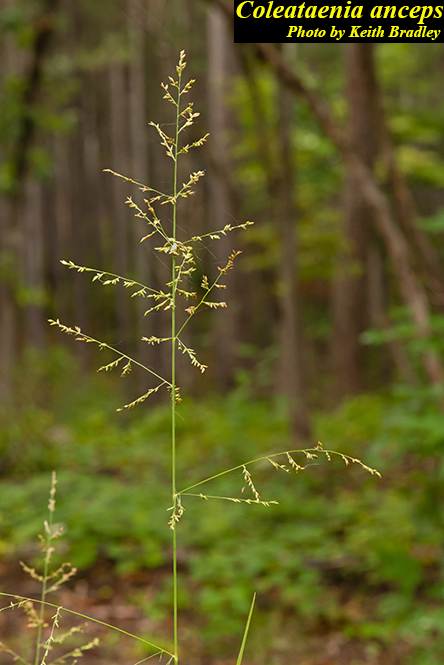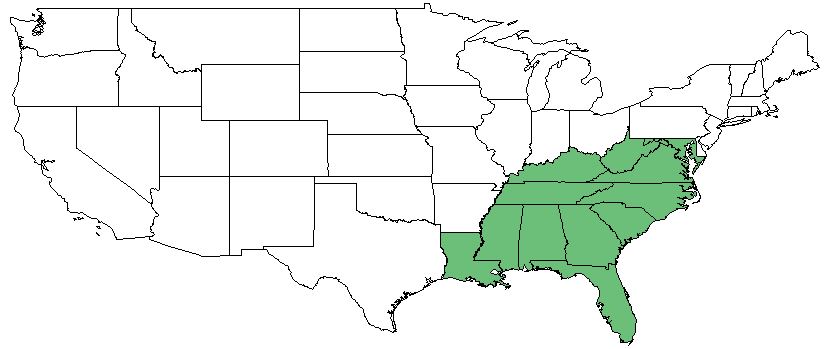Difference between revisions of "Coleataenia anceps"
(→Description) |
(→Habitat) |
||
| Line 34: | Line 34: | ||
==Ecology== | ==Ecology== | ||
===Habitat=== | ===Habitat=== | ||
| − | ''C. anceps'' is tolerant of a variety of habitats such as dry sandy soil and standing water regions; however, swamp regions are its ideal habitat, with partial shade. <ref name= "USDA"> [https://plants.usda.gov/core/profile?symbol=CEAM USDA Plant Database]</ref> | + | ''C. anceps'' is tolerant of a variety of habitats such as dry sandy soil and standing water regions; however, swamp regions are its ideal habitat, with partial shade. It is listed as a facultative and facultative wetland species, occurring mainly in wetlands but also occasionally in non-wetlands.<ref name= "USDA"> [https://plants.usda.gov/core/profile?symbol=CEAM USDA Plant Database]</ref> |
Specimens of ''C. anceps'' have been collected from habitats including upper tidal swamps, edge of rivers, in dune swale, ind rying sandy loam of open flatwoods, burned over cypress swamp, pine flatwoods, moist sands of roadsides, moist sands in hammock clearing, and longleaf pine flatwoods. <ref name = "FSU herbarium"> URL: http://herbarium.bio.fsu.edu. Last accessed: June 2018. Collectors: M. Darst, R. Mattson, G. Mahon, J. Good, Loran Anderson, Ann F. Johnson, R.K. Godfrey, R. Fral, J.P. Gillespie, Richard S. Mitchell, William Reese, Paul Redfearn, R.E. Perdue. States and counties: Florida (Dixie, Wakulla, Bay, Leon, Franklin, Nassau, Madison, Taylor, Jackson, Jefferson, Clay, Levy, Baker) Georgia (Grady) </ref> | Specimens of ''C. anceps'' have been collected from habitats including upper tidal swamps, edge of rivers, in dune swale, ind rying sandy loam of open flatwoods, burned over cypress swamp, pine flatwoods, moist sands of roadsides, moist sands in hammock clearing, and longleaf pine flatwoods. <ref name = "FSU herbarium"> URL: http://herbarium.bio.fsu.edu. Last accessed: June 2018. Collectors: M. Darst, R. Mattson, G. Mahon, J. Good, Loran Anderson, Ann F. Johnson, R.K. Godfrey, R. Fral, J.P. Gillespie, Richard S. Mitchell, William Reese, Paul Redfearn, R.E. Perdue. States and counties: Florida (Dixie, Wakulla, Bay, Leon, Franklin, Nassau, Madison, Taylor, Jackson, Jefferson, Clay, Levy, Baker) Georgia (Grady) </ref> | ||
<!--Natural communities, human disturbed habitats, topography, hydrology, soils, light, fire regime requirements for removal of competition, etc.--> | <!--Natural communities, human disturbed habitats, topography, hydrology, soils, light, fire regime requirements for removal of competition, etc.--> | ||
| + | |||
===Phenology=== | ===Phenology=== | ||
once a year the ''C. anceps'' flowers, in the fall, and produces its seeds that are germinated in the fall and early winter. <ref name= "USDA"> [https://plants.usda.gov/core/profile?symbol=CEAM USDA Plant Database]</ref> | once a year the ''C. anceps'' flowers, in the fall, and produces its seeds that are germinated in the fall and early winter. <ref name= "USDA"> [https://plants.usda.gov/core/profile?symbol=CEAM USDA Plant Database]</ref> | ||
Revision as of 11:35, 8 April 2019
Common Names: Beaked Panicgrass [1]
| Coleataenia anceps | |
|---|---|

| |
| Photo by the Atlas of Florida Plants Database | |
| Scientific classification | |
| Kingdom: | Plantae |
| Division: | Magnoliophyta - Flowering plants |
| Class: | Liliopsida - Moncots |
| Order: | Cyperales |
| Family: | Poaceae |
| Genus: | Coleataenia |
| Species: | C. anceps |
| Binomial name | |
| Coleataenia anceps Michx. | |

| |
| Natural range of Coleataenia anceps from Weakley [2] | |
Contents
Taxonomic Notes
Synonyms: Panicum anceps Michaux; Sorengia anceps (Michaux) Zuloaga & Morrone ssp. anceps; Panicum anceps Michaux var. anceps; Panicum anceps Michaux ssp. anceps; Sorengia anceps (Michaux) Zuloaga & Morrone ssp. rhizomata (A.S. Hitchcock & Chase) Zuloaga & Morrone; Panicum anceps Michaux var. rhizomatum (A.S. Hitchcock & Chase) Fernald; Panicum anceps Michaux ssp. rhizomatum (A.S. Hitchcock & Chase) Freckmann & Lelong; Panicum rhizomatum A.S. Hitchcock & Chase
Varieties: none
Subspecies: Coleataenia anceps (Michaux) Soreng ssp. anceps; Coleataenia anceps (Michaux) Soreng ssp. rhizomata (A.S. Hitchcock & Chase) Soreng
Description
C. anceps is a perennial graminoid of the Poaceae family native to North America. [1]
Differentiating between the subspecies, Coleataenia anceps ssp. rhizomata tends to have hairier leaves than C. anceps ssp. anceps. As well, to differentiate between C. anceps ssp. rhizomata and C. rigidula ssp. condensa, the sheaths of ssp. rhizomata vary from sparsely to densely villous, principally near the margin, while ssp. condensa are either completely glabrous or appressed pubescent distally.[2]
Distribution
This weedy graminoid can be found in the United States, from the east coast west to Illinois and Texas. [2]
Ecology
Habitat
C. anceps is tolerant of a variety of habitats such as dry sandy soil and standing water regions; however, swamp regions are its ideal habitat, with partial shade. It is listed as a facultative and facultative wetland species, occurring mainly in wetlands but also occasionally in non-wetlands.[1]
Specimens of C. anceps have been collected from habitats including upper tidal swamps, edge of rivers, in dune swale, ind rying sandy loam of open flatwoods, burned over cypress swamp, pine flatwoods, moist sands of roadsides, moist sands in hammock clearing, and longleaf pine flatwoods. [3]
Phenology
once a year the C. anceps flowers, in the fall, and produces its seeds that are germinated in the fall and early winter. [1]
Use by animals
Deer graze on the grass and birds and waterfowl eat the seeds. [1]
Conservation and Management
Cultivation and restoration
This grassy wwed has been used for restoring regions used for mining, logging, timber roads, and other eroded sites by reintroducing vegetation.[1]
Photo Gallery
References and notes
- ↑ 1.0 1.1 1.2 1.3 1.4 1.5 USDA Plant Database
- ↑ 2.0 2.1 2.2 Weakley, Alan S. 2015. Flora of the Southern and Mid-Atlantic States: Working Draft of 21 May 2015. University of North Carolina, Chapel Hill, North Carolina. 1320 pp.
- ↑ URL: http://herbarium.bio.fsu.edu. Last accessed: June 2018. Collectors: M. Darst, R. Mattson, G. Mahon, J. Good, Loran Anderson, Ann F. Johnson, R.K. Godfrey, R. Fral, J.P. Gillespie, Richard S. Mitchell, William Reese, Paul Redfearn, R.E. Perdue. States and counties: Florida (Dixie, Wakulla, Bay, Leon, Franklin, Nassau, Madison, Taylor, Jackson, Jefferson, Clay, Levy, Baker) Georgia (Grady)